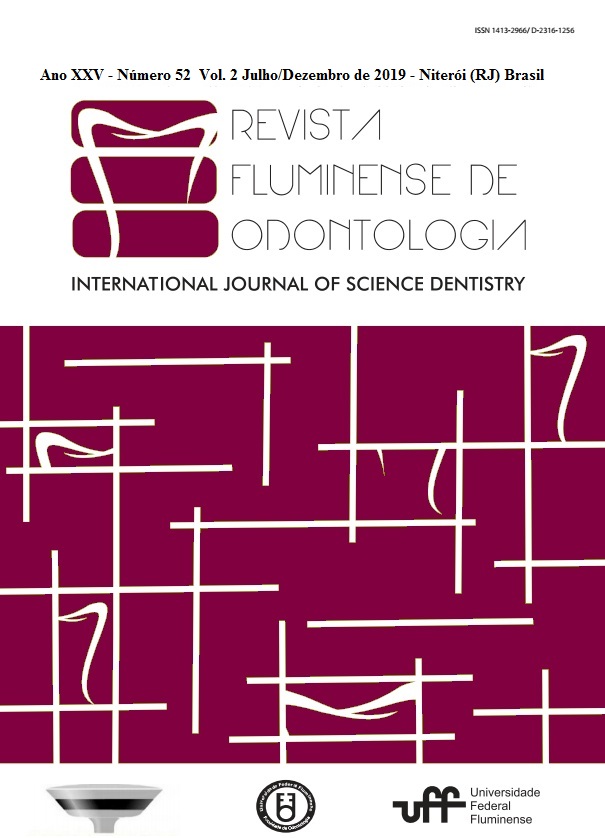ATUALIZAÇÃO SOBRE ETIOLOGIA E TERAPIA DAS INFECÇÕES CERVICOFACIAIS DE ORIGEM ODONTOGÊNICA
DOI:
https://doi.org/10.22409/ijosd.v0i0.38509Resumo
RESUMO
No ambiente hospitalar, percebe-se com frequência a ocorrência de casos de celulites e abscesso na região cervicofacial de origem odontogênica, principalmente relacionados ao comprometimento pulpar dos elementos dentários. Elas provêm das estruturas constituintes dos dentes e periodonto, sendo a maioria de etiologia polimicrobiana, devido à diversidade da microbiota bucal. Do grupo das bactérias aeróbias mais frequentes, causadoras dessas infeccões, destacam-se Streptococcus do grupo viridans, Streptococcus pyogenes, Staphylococcus aureus e Klebsiella pneumoniae. Dos anaeróbios destacam-se Peptostreptococcus, Bacteroides, Prevotella e Fusobacterium. A terapia antimicrobiana preconizada para estas infecções inclui combinações de amoxicilina-clavulanato e metronidazol ou amoxicilina-clavulanato e clindamicina. Atualmente, observa-se uma dificuldade crescente nesses tratamentos, necessitando de múltiplos agentes antimicrobianos. Isso parece estar relacionado à ocorrência de resistência bacteriana aos antibióticos mais comuns e demanda estudos que determinem a susceptibilidade das amostras isoladas nestes processos infecciosos. Para o sucesso terapêutico, pode ser necessária a internação do paciente, pelo risco de disseminação da infecção para outros sítios, além da ocorrência de trismo, gerando dificuldade de alimentação e necessidade do acesso endovenoso do medicamento. O tratamento consiste, de antibioticoterapia adequada, drenagem e remoção da causa, ou seja, tratamento adequado do dente envolvido, o que envolve exodontia ou tratamento endodôntico. Considerando que em muitas situações a antibioticoterapia inicial não resulta em resposta clínica favorável, o objetivo deste estudo é analisar os dados disponíveis na literatura sobre a etiologia, tratamento e evolução clínica dos quadros infecciosos cervicofaciais de origem odontogênica.
Palavras-chave: Infecção cervicofacial. Infecção odontogênica. Antibioticoterapia. Celulite. Abscesso.
ABSTRACT
In the hospital environment, the occurrence of cases of cellulitis and abscess in the cervicofacial region of odontogenic origin is frequently observed, mainly related to the pulp involvement of the theeth. They come from the structures of the teeth and periodontium, being the majority of polymicrobial etiology, due to the diversity of the buccal microbiota. Streptococcus viridans, Streptococcus pyogenes, Staphylococcus aureus and Klebsiella pneumoniae are among the most common of the aerobic bacteria that cause these infections. Among the anaerobes are Peptostreptococcus, Bacteroides, Prevotella and Fusobacterium. The recommended therapy for these infections include combinations of amoxicillin-clavulanate and metronidazole or amoxicillin-clavulanate and clindamycin. Currently, there is an increasing difficulty in these treatments, requiring multiple antimicrobial agents. This seems to be related to the resistance to the most common antibiotics and requires studies to determine the susceptibility of the species in these infections. For therapeutic success, it may be necessary to hospitalize the patient, the risk of dissemination of the infection to other sites, in addition to the occurrence of trismus, generating difficulty in feeding and need for intravenous drug access. The treatment consists of adequate antibiotic therapy, drainage and removal of the cause, that is, adequate treatment of the involved tooth, which involves exodontia or endodontic treatment. Considering that in many situations initial antibiotic therapy does not result in a favorable clinical response, the objective of this study is to analyze data available in the literature on the etiology, treatment and clinical evolution of cervicofacial infections of odontogenic origin.
Keywords: Cervicofacial infection. Odontogenic infection. Antibiotic therapy. Cellulitis. Abscess.




